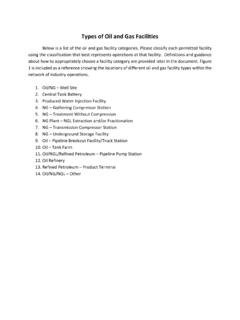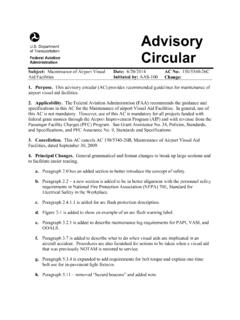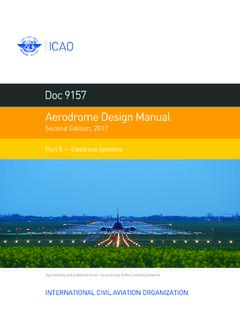Transcription of TITLE 252. DEPARTMENT OF ENVIRONMENTAL QUALITY …
1 Codification through the 2020 Legislative session Subchapters 19 and 27. Board adoption February 21, 2020. Approved by Governor's declaration on June 25, 2020. Effective date - September 15, 2020. TITLE 252. DEPARTMENT OF ENVIRONMENTAL QUALITY . CHAPTER 515. MANAGEMENT OF SOLID WASTE. Subchapter Section 1. General Provisions 252:515-1-1. 3. Permit Provisions and Applications 252:515-3-1. 5. Location Restrictions 252:515-5-1. 7. Subsurface investigation 252:515-7-1. 9. Groundwater monitoring /Corrective Action 252:515-9-1. 11. Liner Design 252:515-11-1. 13. Leachate Collection and Management 252:515-13-1. 15. Methane Gas monitoring and Control 252:515-15-1. 17. Stormwater Management 252:515-17-1. 19. Operational Requirements 252:515-19-1. 21. Used Tire Processing, Certification, Permits and Compensation 252:515-21-1. 23. Regulated Medical Waste Management 252:515-23-1. 25. Closure and Post-closure Care 252:515-25-1. 27.
2 Cost Estimates and Financial Assurance 252:515-27-1. 29. Exclusion of Prohibited Wastes 252:515-29-1. 31. NHIW Management 252:515-31-1. 33. Waste Collection and Transportation 252:515-33-1. 35. Oklahoma Recycling Initiative 252:515-35-1. 37. Landfill Gas Incentive Payments 252:515-37-1. 39. Oklahoma E-Waste Recycling 252:515-39-1. 41. Roofing Material Recycling 252:515-41-1. 43. Composting Facilities 252:515-43-1. Appendix A. Constituents for Detection monitoring Appendix B. Uppermost Aquifer Protective Values Appendix C. List of Hazardous Inorganic and Organic Constituents Appendix D. Borings in Drilling Plan Appendix E. Borehole Depth Calculation Table Appendix F. NHIW Wastestreams Appendix G. NHIW Certification Form Appendix H. Procedure for Calculating Closure Cost Estimates for Financial Assurance Appendix I. Procedure for Calculating Post-closure Cost Estimates for Financial Assurance 1. SUBCHAPTER 1. GENERAL PROVISIONS.
3 Section 252:515-1-1. Authority and applicability 252:515-1-2. Definitions 252:515-1-3. Terms not defined by Act or rule 252:515-1-4. Test methods and map scales 252:515-1-5. Consideration of other laws 252:515-1-6. Severability 252:515-1-7. Beneficial reuse 252:515-1-8. Special considerations 252:515-1-1. Authority and applicability (a) Authority. This Chapter implements the Oklahoma Solid Waste Management Act, 27A 2-10-101 et seq., and the Oklahoma Waste Tire Recycling Act, 27A 2-11-401 et seq., and was adopted under their authority and the authority of the Oklahoma ENVIRONMENTAL QUALITY Code, 27A 2-1-101 et seq. (b) Applicability. This Chapter applies to: any person who owns, operates, or proposes to own and/or operate any type of solid waste disposal facility identified in OAC 252:515-3-1(a) and (b);. (1) any person who generates, collects, transports, processes, and/or disposes of solid waste and/or waste tires, unless otherwise exempt.
4 (2) incorporated cities and towns in Oklahoma providing solid waste collection and transportation services within the corporate city or town limits;. (3) governmental entities located in the state of Oklahoma desiring to seek reimbursement under the Oklahoma Recycling Initiative; and (4) any person, firm or corporation located in Oklahoma desiring to apply for incentive payments for projects that generate energy by utilizing solid waste landfill methane gas. 252:515-1-2. Definitions The following words or terms, when used in this Chapter, shall have the following meaning, unless the context clearly indicates otherwise. Any term not defined in this Chapter shall be defined as set forth in OAC 252:515-1-3. "Active" means, when used to describe a solid waste disposal facility or a portion thereof ( , active MSWLF or active cell), any solid waste disposal facility, or portion thereof, accepting solid waste as of the effective date of this Chapter, regardless of whether such facility has obtained a solid waste permit from DEQ.
5 "Active life" means the period of operation beginning with the initial receipt of solid waste and ending at completion of closure activities. "Active portion" means: (A) that part of a land disposal facility that has or is receiving waste and that has not received either intermediate or final cover; or (B) solid waste process and storage areas at non-land disposal facilities. "Airport" means a public-use airport open to the public without prior permission, and without restrictions within the physical capacities of available facilities. "Applicant" means any person who applies for a new permit or a modification to an existing 1. permit for a solid waste disposal facility identified in OAC 252:515-3-1(a) and (b). "Aquifer" means a geological formation, group of formations, or portion of a formation capable of yielding significant quantities of groundwater to wells or springs. "Areas susceptible to mass movement" means those areas of influence ( , areas characterized as having an active or substantial possibility of mass movement) where the movement of earth material at, beneath, or adjacent to the land disposal facility, because of natural or man-induced events, results in the downslope transport of soil and rock material by means of gravitational influence.
6 Such areas include, but are not limited to, landslides, avalanches, debris slides and flows, soil fluxion, block sliding, and rock fall. "ASTM" means the American Society for Testing and Materials. "Bird hazard" means an increase in the likelihood of bird/aircraft collisions that may cause damage to the aircraft or injury to its occupants. "Buffer zone" means a designated waste-free area within the permit boundary of a disposal facility, to separate waste handling, processing, and/or disposal activities from adjacent areas. "Citizen collection station" means a designated location that is established or sponsored by a governmental entity and equipped with waste receptacles for exclusive, non-commercial use by individual residents to deposit their own household waste for collection and transportation to a permitted disposal site. "CLIMOCS" means the following publication of the Oklahoma Climatological Survey: Shafer, Mark A.
7 , CLIMOCS: A Climatological Summary of 168 Oklahoma Cooperative Stations, Oklahoma Climatological Survey, February 1993, 184 pp. "Composite liner" means a system installed at a land disposal facility composed of a recompacted clay liner overlain with a flexible membrane liner. "C&D landfill" means a construction/demolition landfill. "Composting facility" means a facility in which material is converted, under thermophilic conditions, to a product with a high humus content for use as a soil amendment or to prevent or remediate pollutants in soil, air, and stormwater run-off. "Construction/demolition waste" means waste composed of the following: (A) asbestos-free waste from construction and/or demolition projects that may include such materials as metal, concrete, brick, asphalt, glass, roofing materials, limited amounts of packing materials, sheetrock, or lumber;. (B) wood waste that may include such materials as yard waste, lumber, woodchips, wood shavings, sawdust, plywood, tree limbs, or tree stumps.
8 (C) yard waste that may include such materials as grass clippings, tree limbs, tree stumps, shrubbery, flowers, or other vegetative matter resulting from land clearing or landscaping operations; or (D) residential lead-based paint waste. "Contaminated stormwater" means: (A) water such as leachate and gas collection condensate, or stormwater that has come into direct contact with solid waste or waste handling and/or treatment areas;. (B) stormwater discharged from areas of a land disposal facility with less than six inches of waste-free, compacted earthen material; or (C) wastewater resulting from washing vehicles or areas that are or have been in direct contact with solid waste. "DEQ" means the Oklahoma DEPARTMENT of ENVIRONMENTAL QUALITY . "Disease vector" means rodents, flies, mosquitoes, or other animals, including insects, capable 2. of transmitting disease to humans. "Displacement" means the relative movement of any two sides of a fault measured in any direction.
9 "Disposal" means the final disposition of waste and shall be taken to include any discharge, deposit, injection, dumping, spilling, leaking, or placing of waste into or on the land or water so that the waste or any constituent thereof may enter the environment, including the air and any surface waters or ground waters. "Disposal area" means that part of a land disposal facility where waste is disposed. "Disposal facility" means disposal site as defined at 27A 2-10-103. "Engineer" means a licensed, professional engineer. "EPA" means the United States ENVIRONMENTAL Protection Agency. "Existing" means, when used to describe a solid waste disposal facility or portion thereof ( existing MSWLF or existing cell), any solid waste disposal facility, or portion thereof, that had a solid waste permit as of the effective date of this Chapter. "Facility" means all contiguous land and structures, other appurtenances, and improvements on the land used for the handling, processing, storage, and/or disposal of solid waste.
10 "Fault" means a fracture or a zone of fractures in any material along which strata on one side have been displaced with respect to that on the other side. "Final closure" means a disposal facility has permanently ceased to accept solid waste for disposal and all required closure activities have been completed for the entire facility in accordance with the approved closure plan. Final closure is not synonymous with phased closure. "Flood" means the general and temporary condition of partial or complete inundation of normally dry land areas from the overflow of a lake, stream, river or other body of surface water, or the unusual and rapid accumulation or runoff of surface waters from any source. "Flood, One hundred year (100 year)" means a flood that has a one percent or greater chance of occurrence in any given one year period, or of a magnitude equaled or exceeded once in 100 years on the average over a significantly long period.











